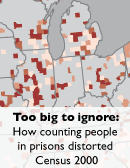
Too big to ignore:
How counting people in prisons distorted Census 2000
By Rose Heyer and Peter Wagner
Prison Policy Initiative
April 2004
Section:
FOR IMMEDIATE RELEASE
Contact:
Peter Wagner, Assistant Director
Prison Policy Initiative
(413) 527-0845
New study says how the Census counts prisoners frustrates accurate use of data
Too big to ignore: How counting people in prisons distorted Census 2000
Cincinnati, OH (April 13, 2004) - The Prison Policy Initiative, an organization that conducts research and advocacy on incarceration policy, today released the first national analysis of how Census counts of incarcerated people distorts Census data.
"Too big to ignore: How counting people in prisons distorted Census 2000" looks at the figures for county population size, growth, race, ethnicity, gender and income.
"Fifty seven counties that Census 2000 reported as growing during the previous decade actually saw population decline without the inclusion of prisoners" said report co-author Rose Heyer.
There are currently over 2 million people incarcerated in the United States. Requiring prisoners to use the prison's address dates back to the original Census, but "it's an outdated concept that predates both modern uses of Census data and high incarceration," said report co-author and Soros Justice Fellow Peter Wagner. "Since the first census in 1790, the Census Bureau has continually updated its methodology. When evolving demographics and politics meant more college students studying far from home and more Americans living overseas, the Census policy changed in order to more accurately reflect how many Americans were living where."
The report includes national maps of the impact on county size, population growth, race, ethnicity and gender. "Too big to ignore" offers suggestions to data users on where to expect distortions in local Census data and argues that the Census Bureau should update its methodology on counting incarcerated people to count them at their home addresses.
Findings include:
- Twenty one counties in the United States have at least 21% of their population in correctional facilities.
- One out of every 50 counties reported as growing during the 1990s actual saw a decline in the actual population. New prison cells made these counties appear to be growing.
- Census data report rapidly growing Black populations in rural white counties. This population consists not of willing migrants but primarily of prisoners moved to the county for temporary incarceration.
- Many counties report concentrations of Latino adults without many children. These too are frequently the results of a prison in the community.
- Many of the counties where unmarried men outnumber unmarried women are counties with large male prisons. This ratio is useful for government planning, but due to the impact of prisons is difficult to use below the state level.
- Inclusion of prisoners in per-capita income figures complicates efforts to study and address rural and urban poverty.
The report is available at: http://www.prisonersofthecensus.org/toobig/index.html
About the Prison Policy Initiative
The Cincinnati-based Prison Policy Initiative (PPI) conducts research and advocacy on incarceration policy. Its work starts with the idea that the racial, gender and economic disparities between the prison population and the larger society represent the grounds for a democratic catastrophe. PPI's concept of prison reform is based not only in opposition to a rising rate of incarceration, but in the search for a lasting solution to pressing social problems superior to temporarily warehousing our citizens in prisons and jails. For more information about PPI or prison policy in general, visit http://www.prisonpolicy.org.
For more information including full color maps illustrating how Census counts of prisoners distort legislative redistricting, see http://www.PrisonersoftheCensus.org
###
Events
- April 15-17, 2025:
Sarah Staudt, our Director of Policy and Advocacy, will be attending the MacArthur Safety and Justice Challenge Network Meeting from April 15-17 in Chicago. Drop her a line if you’d like to meet up!
Not near you?
Invite us to your city, college or organization.



